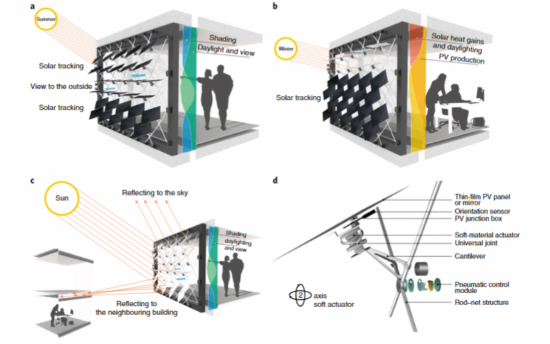July 14, 2019 – In rethinking the way we build and cover vertical surfaces, a group of researchers including Arno Schlueter of the Swiss Federal Institute of Technology Zurich, have designed a building envelope that serves three purposes: managing passive heating, shading and daylight penetration, and generating energy.
The solution is a photovoltaic envelope that utilizes lightweight solar panels and robotically-controlled actuators to actively track the sunlight and generate energy while providing a thermal barrier to keep the internal environment of a building comfortable for its inhabitants. The researchers installed a 16-module prototype measuring 3.9 by 3.2 meters (12.8 by 10.5 feet) on one of the Swiss Federal Institute’s buildings and were able to test the performance and stability of the panels under real weather conditions.
Each modular panel was equipped with copper indium gallium selenide (CIGS) solar cells, a thin-film photovoltaic technology, with robotically controlled actuators that performed solar tracking both by moving them horizontally and vertically between 10 and 45 degrees at regular intervals to maximize electric power generation. The facade was oriented 23 degrees from the south and towards the west with electric power gains larger in the morning than in the afternoon. The panels also had to deal with shadow from an adjacent building which reduced direct solar radiation to periods after 10:00 a.m.

Those panels nested below the top units also saw reduced gain because of the shadow cast from above. The researchers recognized this as a tradeoff between solar shading and energy generation, noting that if the overlap were reduced it would impact the thermal balancing effect of the panels on the interior environment negatively. The potential to impair an outside view seemed to be little noticed by those working in the area where the panels were applied. Observers noted that in most window-clad vertical construction, they would be using blinds as shading devices regularly to cut out the heat and glare. In this case the panels did this automatically.
One of the positive aspects of this technology is its ability to adapt to changing environmental conditions happening outside the building. It can be set up with mulitple controllers for multiple modules and applied almost anywhere on a vertical, angled, or horizontal surface. And because the modules are scalable it can be used in small and large form factors, for both new construction and retrofits. And with the ability to integrate the robotic pneumatic controls or operate them singly, by groups, by rows, or in total depending on the installation need, the technology presents considerable adaptability.
During the test in Zurich, the 16-module prototype was exposed to temperatures between 3 and 20 Celsius (37 to 68 Fahrenheit) and wind speeds of up to 30 kilometers (18 miles) per hour. Under such conditions the pneumatic robotic-controlled actuators proved stable and energy gains over consumption varied from 28 to 50% when compared to vertical static solar panels mounted on the same building.
















